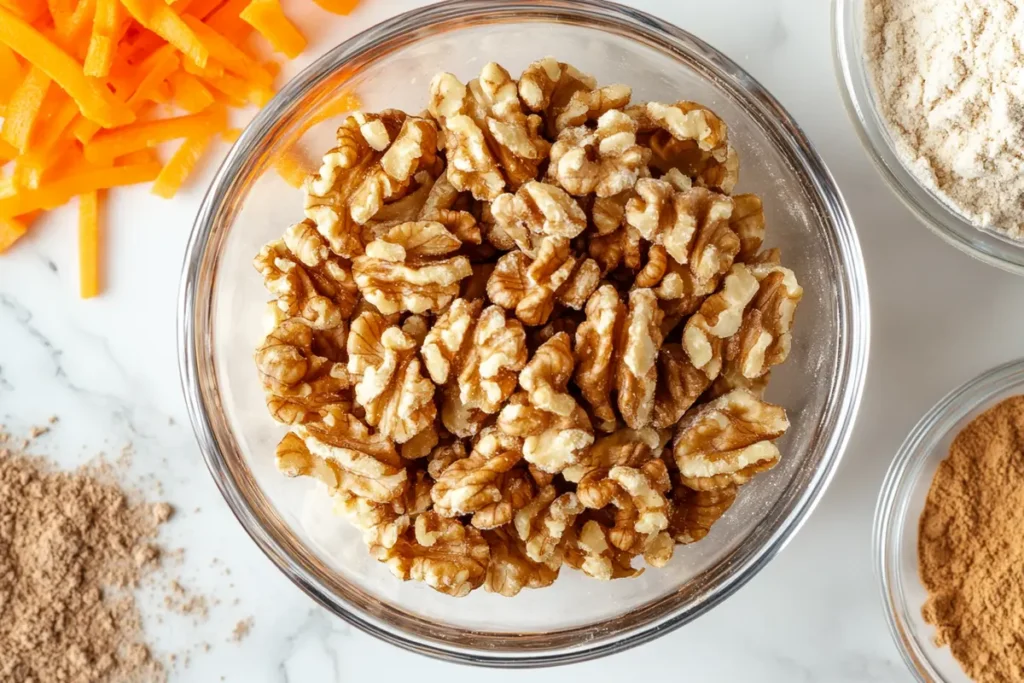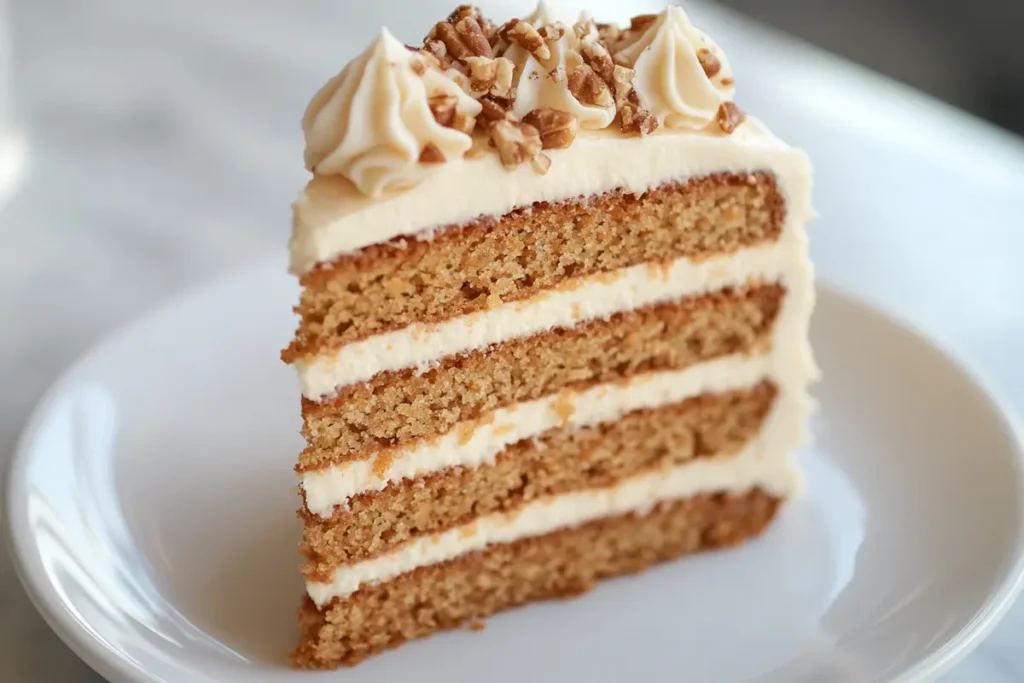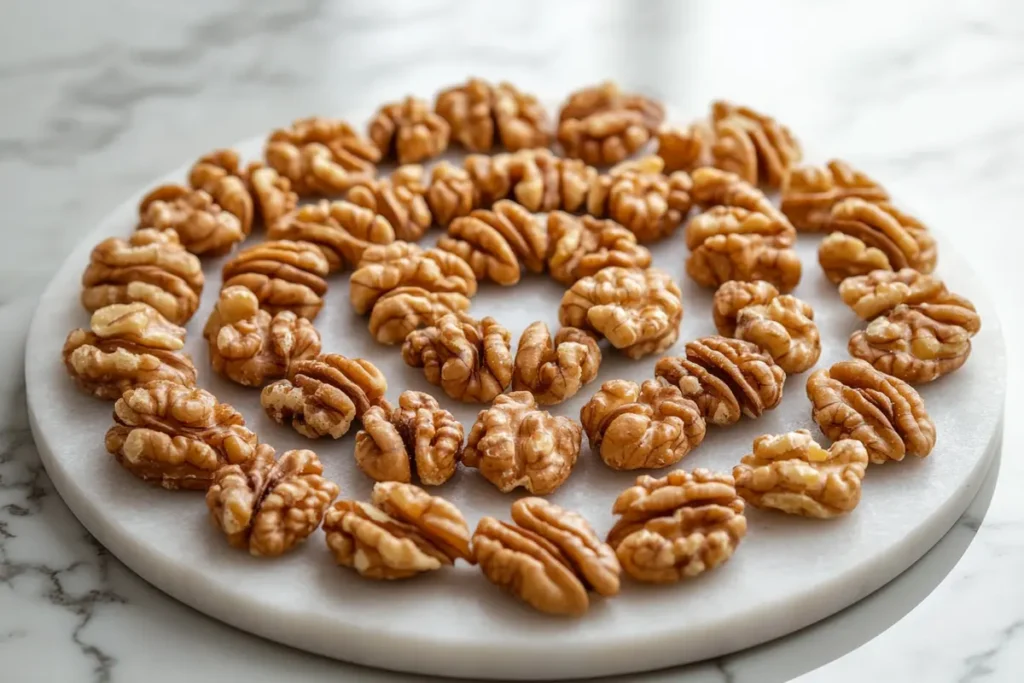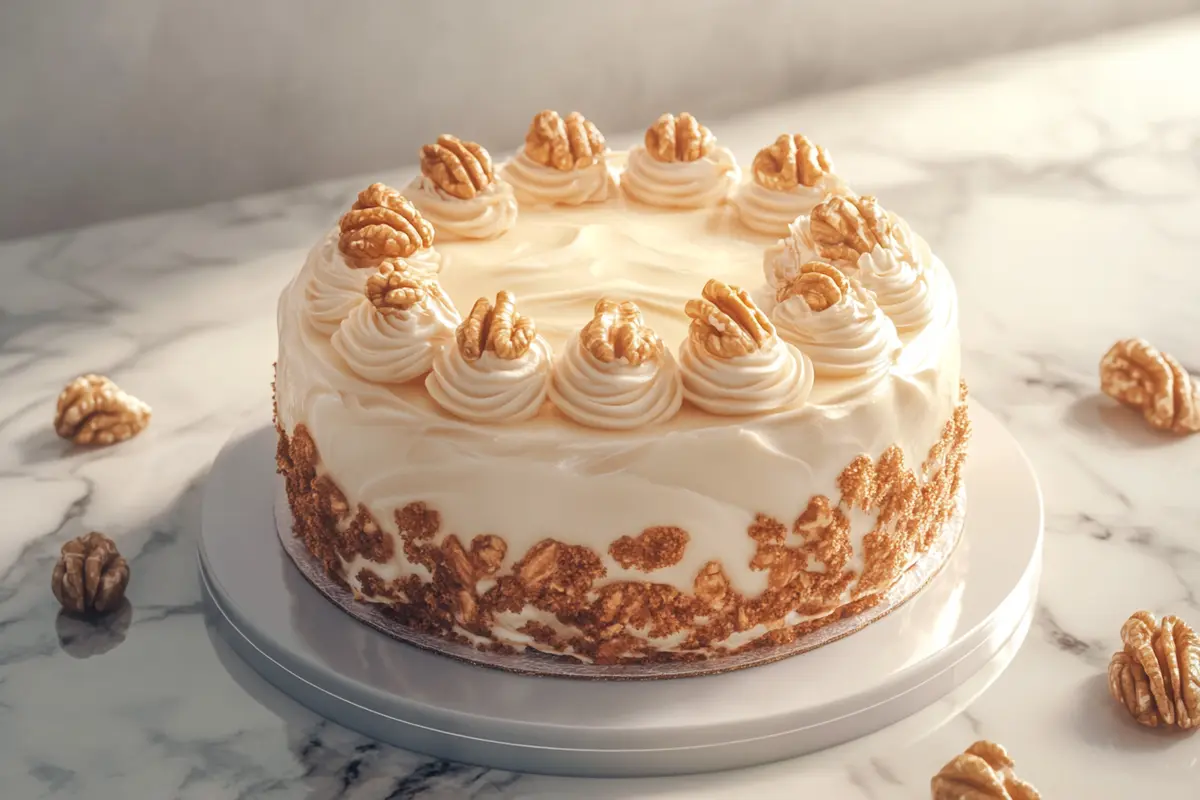Carrot cake is a timeless dessert loved for its moist texture, spiced flavors, and rich cream cheese frosting. However, bakers sometimes encounter an unexpected issue: Why do walnuts go black in carrot cake? The sight of discolored walnuts can be puzzling, especially for those aiming for a perfect presentation. This article dives deep into the science behind walnut discoloration, common mistakes that lead to it, and actionable tips to prevent it from happening. You’ll also find a tried-and-true carrot cake recipe featuring walnuts, complete with nutritional details. Let’s get started!
Understanding the Science Behind Walnuts Turning Black
Chemical Reactions During Baking
When walnuts turn black in carrot cake, it’s often due to chemical reactions that occur during baking. Specifically, walnuts contain tannins, a natural compound found in many nuts, which can react with other ingredients in the batter.
- Oxidation: When tannins in walnuts are exposed to oxygen and heat, they can darken, leading to black or brown spots.
- Metal Ions: Using certain baking utensils or pans, like those made of aluminum or copper, can intensify this reaction. The metal ions interact with the tannins, amplifying the discoloration.
For example, if you’re using a high-acid ingredient like vinegar or citrus juice, the reaction can become even more pronounced.
The Impact of Acidity and Moisture
The acidity in the batter also plays a major role in walnut discoloration. Ingredients like vinegar, buttermilk, or even baking soda can alter the pH levels, creating an environment where tannins react more aggressively.
Additionally, too much moisture in the batter can exacerbate the issue. Excess liquid allows tannins to seep out of the walnuts more easily, spreading their color throughout the cake.

Common Mistakes That Lead to Black Walnuts
Overmixing the Batter
One common mistake that leads people to ask, Why do walnuts go black in carrot cake?, is overmixing the batter. When you overmix, the oils in the walnuts are released excessively, causing tannins to interact with other ingredients more intensely. This reaction can result in darker, discolored walnuts.
For best results, mix your batter until the ingredients are just combined. Furthermore, fold in the walnuts gently to ensure they are evenly distributed without over-processing them.
Choosing Low-Quality Walnuts
The quality of walnuts can make a big difference in their behavior during baking. Old or improperly stored walnuts are more likely to turn black because they’ve started to oxidize even before entering the batter.
To avoid this issue, always check for freshness. Fresh walnuts should have a light, even color and a mild, nutty aroma. Rancid nuts, on the other hand, will smell bitter and appear darker. Storing walnuts in an airtight container in the refrigerator or freezer can help preserve their freshness for longer.
Pro Tip: If you’re unsure about the quality of your walnuts, toast them lightly before adding them to the batter. This process reduces moisture content and intensifies their flavor, making them less prone to discoloration.
For more insights on using walnuts in baking, explore our Carrot Walnut Cake Recipe.
Preventing Walnuts from Turning Black in Carrot Cake
Using Fresh and High-Quality Walnuts
The simplest way to prevent walnuts from turning black is to use fresh, high-quality walnuts. As mentioned earlier, fresh walnuts are less likely to oxidize and release tannins that lead to discoloration. Additionally, proper storage is key:
- Store walnuts in a cool, dry place.
- Use airtight containers to prevent exposure to moisture.
- Refrigerate or freeze walnuts to extend their shelf life.
Furthermore, if you notice any signs of rancidity, discard the walnuts immediately to avoid compromising the flavor and appearance of your carrot cake.
Adjusting Your Recipe for Better Results
Baking is a science, and small changes in your recipe can significantly impact the outcome. Here are some adjustments to help keep walnuts from going black:
- Reduce Acidity: Lower the amount of acidic ingredients like vinegar or buttermilk in your recipe. This reduces the reaction between tannins and acids.
- Balance Moisture: Avoid adding too much liquid to the batter, as it can increase tannin release.
- Use Neutral Utensils: Stick to non-reactive baking pans and utensils, such as those made from stainless steel or glass, to prevent metal ions from intensifying the discoloration.
For example, using a stainless steel mixing bowl instead of aluminum can minimize the chemical reactions that contribute to blackened walnuts.
By implementing these tips, you’ll create a carrot cake with beautifully preserved walnuts.

A Perfect Carrot Cake Recipe with Walnuts
Essential Ingredients for Carrot Cake
To create a delicious carrot cake that avoids the problem of Why do walnuts go black in carrot cake?, you’ll need high-quality ingredients and precise measurements. Here’s what you’ll need:
- 2 cups grated carrots (fresh and finely shredded)
- 1 1/2 cups all-purpose flour
- 1 cup sugar
- 1/2 cup brown sugar
- 3/4 cup vegetable oil
- 2 large eggs
- 1/2 cup crushed pineapple (drained)
- 1 cup fresh walnuts (chopped, toasted for better flavor)
- 1 tsp baking soda
- 1 tsp baking powder
- 1 tsp ground cinnamon
- 1/4 tsp nutmeg
- 1/4 tsp salt
Step-by-Step Cooking Instructions
- Prepare the Ingredients
- Preheat your oven to 350°F (175°C).
- Grease and flour two 9-inch round cake pans or one large loaf pan.
- Toast the walnuts for 5-7 minutes in the oven for added flavor, then let them cool.
- Mix the Dry Ingredients
- In a large mixing bowl, combine the flour, baking soda, baking powder, salt, cinnamon, and nutmeg.
- Whisk the ingredients together until evenly blended.
- Combine the Wet Ingredients
- In another bowl, whisk the sugar, brown sugar, and vegetable oil until smooth.
- Add the eggs one at a time, mixing well after each addition.
- Stir in the grated carrots and crushed pineapple.
- Fold in the Walnuts
- Gently fold in the walnuts, ensuring they’re evenly distributed throughout the batter.
- Be careful not to overmix, as this can lead to dense cake and discolored walnuts.
- Bake the Cake
- Pour the batter evenly into the prepared pans.
- Bake for 25-30 minutes or until a toothpick inserted into the center comes out clean.
- Cool and Frost
- Let the cakes cool completely on a wire rack before adding frosting.
- Use cream cheese frosting for a traditional touch or opt for a light glaze for a less rich option.
Nutritional Content of Carrot Cake with Walnuts
Nutritional Benefits of Walnuts in Carrot Cake
Adding walnuts to carrot cake doesn’t just improve texture and flavor—it also boosts the nutritional value. Walnuts are rich in omega-3 fatty acids, which promote heart health, and they provide a good source of protein and fiber. Carrots, on the other hand, are packed with beta-carotene, supporting eye health and immune function.
Nutritional Information (Per 100g)
Here’s an approximate breakdown of the nutritional content for carrot cake with walnuts:
| Nutrient | Amount per 100g |
|---|---|
| Calories | 350 |
| Protein | 5g |
| Fat | 20g |
| Carbohydrates | 40g |
| Fiber | 3g |
| Sugar | 25g |
| Vitamin A | 4000 IU |
| Calcium | 40mg |
For more dessert ideas and baking tips, check out our Carrot Walnut Cake Recipe.
FAQs About Black Walnuts in Carrot Cake
Why Do Walnuts Go Black in Carrot Cake?
This is one of the most common questions bakers ask. The discoloration occurs due to tannins in the walnuts reacting with oxygen, moisture, or acidic ingredients in the batter. In particular, the high heat of baking can intensify this reaction, causing the walnuts to turn dark.
If you’ve been wondering, Why do walnuts go black in carrot cake?, it’s important to consider the freshness of your walnuts, as older nuts are more prone to discoloration. Additionally, using non-reactive utensils and adjusting the recipe’s pH can minimize the problem.
Can I Use Other Nuts Instead of Walnuts?
Yes, you can! If you want to avoid the issue of walnuts going black, substitute them with nuts like pecans or almonds. These alternatives offer a similar crunch and nutty flavor without the risk of discoloration. For nut-free options, try sunflower seeds or raisins to add texture and sweetness to your carrot cake.
Tip: Toasting your chosen substitute before adding it to the batter enhances its flavor, making your cake even more delicious.
How Should Walnuts Be Stored for Baking?
Proper storage is essential for preventing walnut discoloration and maintaining their quality. To keep your walnuts fresh:
- Store them in an airtight container.
- Keep them in the refrigerator or freezer to prevent oxidation.
- Avoid exposure to heat, light, or humidity.
Fresh walnuts are less likely to go black during baking, ensuring a better result for your carrot cake.
Final Thoughts on Baking Carrot Cake with Walnuts
Does It Matter If Walnuts Go Black?
Although discolored walnuts might not look perfect, they don’t affect the overall taste or safety of the cake. However, if presentation matters—such as for a special occasion—taking steps to prevent discoloration can enhance the cake’s appearance.
Making the Perfect Carrot Cake
Ultimately, carrot cake is a dessert that allows for endless creativity. Whether you include walnuts or choose a substitute, this classic treat can be customized to your taste. By following these tips, you can ensure your walnuts stay fresh and vibrant, creating a carrot cake that’s as beautiful as it is delicious.
For more dessert ideas and expert baking tips, explore our Carrot Cake Recipe Collection.

Exploring Creative Solutions for Baking with Walnuts
Experimenting with New Techniques
When tackling the issue of Why do walnuts go black in carrot cake?, trying out innovative techniques can transform your baking experience. A simple yet effective solution is coating the walnuts in flour before mixing them into the batter. This small adjustment creates a thin barrier that prevents direct interaction between the nuts and the batter’s acidic or moist components, which often cause discoloration.
Another idea is to blanch the walnuts. To do this, immerse them in boiling water for about one minute, then rinse them under cold water. By blanching, you remove some of the surface tannins, which are responsible for turning walnuts black during baking. Let the nuts dry completely before using them in your recipe.
In addition, you might consider lightly roasting the walnuts before adding them to the batter. Roasting not only enhances their natural nutty flavor but also reduces their moisture content. This process can help limit the release of tannins during baking.
Experimenting with Unique Ingredients
If you’d rather skip walnuts entirely to avoid the question of discoloration, there are several exciting alternatives to try:
- Pine Nuts: These delicate nuts provide a buttery flavor and a softer texture.
- Sesame Seeds: A sprinkle of toasted sesame seeds adds an unexpected twist and subtle crunch.
- Chopped Dates or Figs: Dried fruits can bring a chewy sweetness that complements carrot cake beautifully.
Furthermore, mixing in shredded coconut or crushed pineapple can provide moisture and texture, giving the cake a tropical flair.
Customizing the Presentation
Sometimes, the discoloration is more about presentation than taste. To keep your carrot cake visually appealing, you can limit walnuts to a decorative topping. Use whole walnuts or halves on the frosting, allowing the rich cream cheese layer to act as a barrier between the nuts and the cake’s moisture. Alternatively, consider dusting the cake with powdered sugar or drizzling a glaze before adding the nuts for a polished finish.
By experimenting with these techniques and substitutes, you can create a carrot cake that is not only visually stunning but also tailored to your personal taste preferences.
Final Thoughts: Why Do Walnuts Go Black in Carrot Cake?
Understanding the Role of Walnuts in Carrot Cake
When it comes to creating the perfect carrot cake, walnuts often take center stage as a key ingredient. They add texture, a subtle crunch, and a nutty richness that enhances the overall flavor profile of the cake. However, the question Why do walnuts go black in carrot cake? has puzzled many bakers over the years.
The blackening of walnuts is primarily caused by the interaction of tannins with moisture, heat, and acidic ingredients in the batter. For example, acidic components like vinegar or citrus juice can intensify the tannin reaction, leading to discoloration. Moreover, improper storage or using older walnuts can increase the likelihood of this issue. Understanding these factors is the first step toward addressing the problem.
Tips for Crafting the Perfect Walnut Carrot Cake
To ensure your walnuts remain visually appealing while maintaining their flavor, follow these practical tips:
- Choose Fresh Walnuts: Always opt for fresh, high-quality walnuts. Older nuts are more prone to oxidation, which can lead to blackening.
- Store Properly: Keep walnuts in an airtight container and refrigerate or freeze them to preserve freshness.
- Minimize Acidity: Reduce acidic ingredients in your recipe to create a more neutral environment for the walnuts.
- Coat Walnuts Before Mixing: Lightly dusting walnuts with flour before folding them into the batter can reduce direct contact with moist or acidic components.
- Consider Decorative Use: Use walnuts as a garnish instead of mixing them into the batter. This approach avoids discoloration while still delivering their signature crunch and flavor.
Experimenting with Variations
If you’re hesitant to include walnuts due to the potential for discoloration, don’t let this deter you from enjoying carrot cake. Instead, try experimenting with substitutes like pecans, sunflower seeds, or even chocolate chips. These alternatives can provide unique textures and flavors while bypassing the issue of black walnuts.
Additionally, consider adjusting the recipe to make it more visually appealing. For instance, using candied walnuts as a topping or incorporating shredded coconut can add flair without compromising on taste.
The Versatility of Carrot Cake
Carrot cake is beloved not only for its flavor but also for its flexibility. Whether you include walnuts or opt for a nut-free version, this dessert remains a crowd-pleaser. Its moist, spiced layers paired with creamy frosting make it a timeless treat for birthdays, holidays, or casual gatherings.
Ultimately, the answer to Why do walnuts go black in carrot cake? lies in understanding the science behind baking and taking steps to prevent discoloration. With the right techniques and adjustments, you can craft a carrot cake that looks as amazing as it tastes.
For more baking tips and creative recipes, check out our Guide to Baking with Walnuts.

